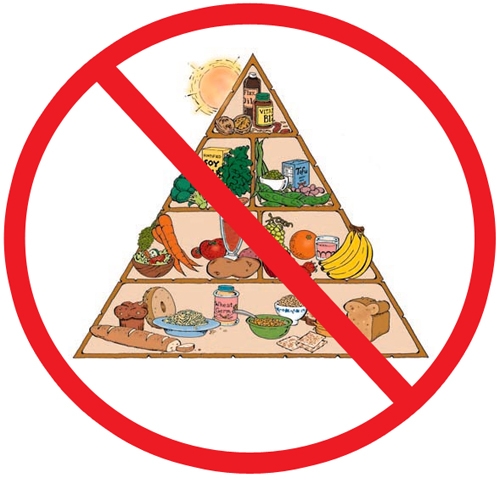Politics and the Food Pyramid

Historically, the first idea or origin of the so-called Food Pyramid came from the US in the field of agricultural chemistry and an agricultural chemist in the person of Wilbur Olin Atwater wrote the dietary plan and guideline. Sometime in 1902 or probably later, Mr Atwater wrote and published the importance of proportionality, variety and moderation in healthy diets of Americans especially the males. Mr Atwater in his research determined that the diet’s efficiency can be measured by the calorie. He also emphasized and stressed on the importance of a cheap but efficient daily diet that included proteins, vegetables and beans, and to limit on sugar, fat, starch and other carbohydrates.
Five years later, the United States Department of Agriculture (USDA) issued its first food guidelines titled “How to Select Foods” written by its nutritionist, Caroline Hunt. Noticeably though, whether politically influenced or not, the said guidelines ignored Dr Atwater’s findings on the importance of limiting sugar and fat intake and the emphasis on taking vitamins and minerals. Hunt’s recommended food were grouped as follows: 1) meat and milk, 2) cereals, 3) vegetables and fruits, 4) fatty foods and fat, and 5) sugary food and sugar.
In 1940, the Recommended Dietary Allowances or RDA was released and the USDA altered its recommendations again. Subsequently it came up with a National Nutrition Guide in 1946 offering 7 food groups in support of the RDA requirements, as follows: 1) Milk including milk products, 2) Meat, poultry and eggs, fish, peas, beans, and nuts, 3) Cereals, flour and Bread, 4) Leafy green or yellow vegetables, 5) Potatoes and sweet potatoes, 6) Citrus, tomato, cabbage, sand salad greens, and 7) Butter and fortified margarine.
Several other guides followed and all with conflicting advice and in 1956 owing to the confusion the various food recommendations were revised and decreased to the “Basic Four” recommendation. This was published and the 4 basic food groups included meat, milk, grain products and fruits and vegetables. As early as this century, hidden forces were already trying to influence the food market by manipulating the recommendations that would possibly affect the entire American nation.
In 1969, Senator George McGovern proposed that consumption of fat and cholesterol should be limited as they are dangerous to the heart although no actual scientific study or research could already prove this connection at the time. This premise that was politically proposed eventually led to the creation of USDA’s first Food Pyramid. Indeed, political intervention was already evident at the time that still continues up to the present.
In January 1977, the same Committee finally published the a document supporting the unproven notion that fat, cholesterol and heart ailment are related and recommended that consumption of these substances should be reduced and that Americans should instead increase carbohydrate consumption to 60% of their daily calories. This is contrary to the fact that too much carbohydrate is also bad for your health.
Right after the dietary guidelines were released, the cattle and poultry raisers as well as the dairy manufacturers went mad as it would seem Congress itself was trying to convince the American populace that animals and animal products were a bane to their health. This kind of propaganda really affected the consumption of these products and even if the report was finally revised in 1977 due to the intense demand from the concerned industries, egg, milk and meat consumption still went down.
At first the USDA refrained from adopting the guidelines because of contradictions but eventually in 1980,the first edition of the dietary guidelines was issued and became the official USDA Food Pyramid.
This however is only one side of the history of the Food Pyramid story because the first food pyramid ever introduced publicly was actually invented in Sweden by a certain Anna Britt Agnsäter, an employee of the Swedish Cooperative Union who developed the idea of a triangular model of the Pyramid. The scheme was to separate the basic food from the supplementary like minerals and vitamins. Food prices were then very high in Sweden and the Food Pyramid was invented out of necessity with the purpose of prioritizing cheap food products that have high nutritional value.
The Swedish Food Pyramid, however, showed some distinct differences with the American Food Pyramid. For example, you may observe that dairy has its own separate section in the American version while in the Swedish version; dairy is simply combined with the other basic foods. This is not an accident but purposely done to suggest that dairy is essential in the food diet which is not necessarily true as most people in many cultures do not drink milk and they are still in perfect health. Why dairy is considered so in the American Pyramid is obviously the work of people who will benefit from this ploy to encourage the American public to buy more milk and other dairy products. We can almost say that the dairy industry pressed and lobbied for this modification.
You will also notice that American Pyramid suggests rather large servings of starchy food such as cereal, pasta and bread per day. This particular recommendation would also seem to benefit the wheat growers most primarily. During the formulation of this particular Food Pyramid it is said that the Agriculture Secretary’s Office itself made some major changes to win the approval of the food industry. For instance, the said office emphasized the consumption of processed foods over fresh foods and minimize on lean meats and low-fat dairy products, as this would favour the concerned industries.
Because of this anomaly, it is not surprising that obesity rates increased right after the introduction of the said Pyramid. And the USDA has made many questionable decision concerning nutrition recommendations. Just like in 1995 when the Food Pyramid was undergoing revision, the sugar barons then demanded for the change in the Food Pyramid’s wording that says “eat less sugar” to “eat moderate sugar”.
There were other provisions and phrases in the Food Pyramid, which should have been beneficial to the American public, but the affected industries urged for their alteration to consequently favour their business. These and other irregularities are what we call politics in the food industry and helped shape, although in a distorted manner, the present food consumption preferences and requirement of the American public.
Leave a Reply
You must be logged in to post a comment.






Share This